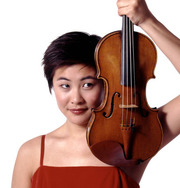
No doubt, Da Camera Houston subscribers were looking forward to Simone Dinnerstein’s all-Bach program this week. But when the acclaimed pianist canceled, citing ill health, the Da Camera folks were left scrambling for a replacement.
On Oct. 23, she played all six of the composer’s sonatas and partitas for unaccompanied violin at New York’s Academy of Arts and Letters. It was a marathon recital that the New York Times called “a feat of physical and imaginative stamina.”
And even though the 35-year-old Korean-American violinist is a seasoned concert artist - well used to the pressures of performing in public – her all-Bach recital was, as she tells it, a very intense experience.
Da Camera’s audience will experience some of that intensity when she plays the three Bach partitas Tuesday at the Menil Collection.
Q: The Bach repertoire that you’ll be playing is unaccompanied; there’s nobody but you, with your violin, on stage. I suspect that there are some violinists – even some very good ones – who would hesitate to do such a thing. How do you feel about it?
A: First of all, let me say that I completely understand why some violinists might be uncomfortable with it – especially with Bach. There’s something so incredibly naked, yet visceral, about playing Bach’s music. It’s not just that you’re exposed technically, but you have to allow yourself to be completely open and vulnerable – almost to an unbearable degree.
It changes you as a person. It’s like walking around with no skin on – or what I imagine babies feel like when they enter the world.
Q: So how is it different from performing with a piano accompanist or with an orchestra?
A: Most of the time when you’re doing concertos, or recital programs with a pianist, you study the music alone, and then come together in rehearsal to share viewpoints and discuss ideas. What’s so different about doing the unaccompanied Bach is that until you reach the point of sharing the music with the audience, you’re all by yourself. It’s a very lonely task.
Q: How did your Bach solo recital in New York come about?
A: Two seasons ago, I played all six sonatas and partitas in separate concerts. And then last week I played all six on one concert, which took about three hours. My close friends, and my former teacher, Jaime Laredo, said, “You are insane!”, because most violinists don’t do them all in one concert. As musicians, they understood that this was a very difficult thing to do. As I was preparing for the recital, one friend – the composer Kaija Saariaho – said I was going through “artistic agony.”
Q: Is performing this music an emotional experience for you?
A: In a way, I feel that my role as a musician is to bring out what I believe the composer is trying to say. So in the moment of playing, you kind of have to separate yourself from the music. But after I did the marathon concert in New York, it was such an emotional experience that I broke down crying after I walked off stage. That’s never happened to me before.
© Colin Eatock 2011
 RSS Feed
RSS Feed

